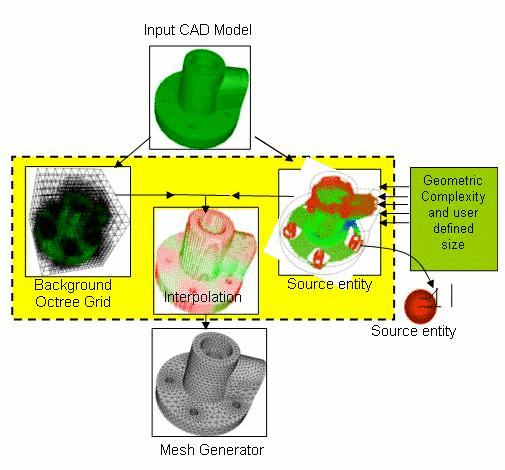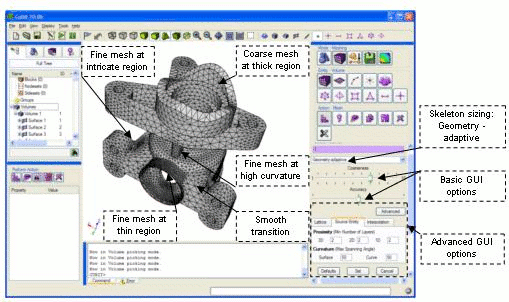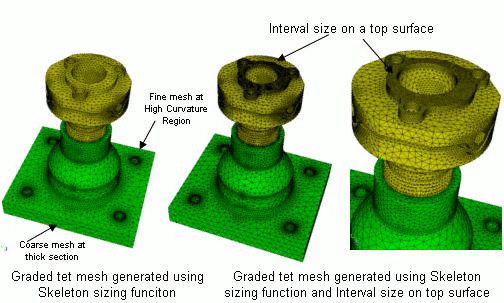Geometry Adaptive Sizing Function (Skeleton Sizing)
The Geometry Adaptive Sizing Function, also referred
to as the Skeleton Sizing Function (Quadros 2005; Quadros
2004; Quadros 2004(2)), automatically generates a mesh sizing function
based upon geometric properties of the model. This sizing scheme attempts
to create a sizing function that allows unstructured meshing schemes to
generate a mesh with the following properties:
- The sizes of the mesh elements vary smoothly throughout the mesh
- The mesh elements resolve the geometry to a sufficient degree
- The mesh elements do not over-resolve the geometry.
The geometry adaptive sizing function can be used to create sizing information
for surfaces, solids, and assemblies.
This sizing function uses geometric properties to influence mesh size.
The scheme calculates or estimates:
- 3D-proximity (thickness though the volume)
- 2D-proximity (thickness across a surface)
- 1D-proximity (curve length)
- Surface curvature
- Curve curvature.
These properties are then used to calculate a sizing function throughout
the geometric entity (or entities). Regions of relatively high complexity
will have a fine mesh size, while regions of relatively low complexity
will have a coarse mesh size. For example, generally, a high-curvature
region on a surface will have a finer mesh size than a low-curvature region
on that surface

Figure 1: Overview of Computational
Framework

Figure 2: Skeleton Sizing
Function example in the GUI
Skeleton Sizing Behaviors
Skeleton sizing can be specified on single or multiple surface(s)/volume(s)
at a time from the GUI (Meshing Control Panel) or the command-line. The
following describes how specifying sizing on entities can change skeleton
sizing’s behavior:
Single surfaces/volumes – If skeleton
sizing is applied to surfaces/volumes one at a time, each entity’s sizing
is not influenced by the others. On the command-line, issue a separate
command for each entity. In the GUI, specify only one surface or volume
before selecting “Apply Size”.
Multiple surfaces – If skeleton
sizing is applied on multiple surfaces together, then geometric features
of a particular surface may affect its neighboring surfaces.
Multiple volumes (assembly sizing)
– Skeleton sizing can be applied to assembly models so that geometric
features of a volume may influence its neighbors. Volumes should first
be imprinted and merged before they are specified together for skeleton
sizing.
Command Line Syntax
Skeleton sizing on surfaces:
Surface <surface_id_range>
Sizing Function Skeleton
{[scale <1 to 10 = 7>] [time_accuracy_level <1 to 3 = 2>]
[min_depth <3 to 8 = 5>] [max_depth <4 to 9 = 7>] [facet_extract_ang
<1 to 30 = 10>]
[min_num_layers_2d < 1 to N = 1>] [min_num_layers_1d < 1 to N
= 1>]
[max_span_ang_surf <5.0 to 75.0 = 45.0 degrees>]
[max_span_ang_curve <5.0 to 75.0 = 45.0 degrees>]
[min_size <float>] [max_size <float>] [max_gradient <float=1.5>]}
Skeleton sizing on volumes:
Volume
<range> Sizing Function Skeleton
{[scale <1 to 10 = 7>] [time_accuracy_level <1 to 3 = 2>]
[min_depth <3 to 8 = 5>] [max_depth <4 to 9 = 7>] [facet_extract_ang
<1 to 30 = 10>]
[min_num_layers_3d < 1 to N = 1>] [min_num_layers_2d < 1 to N
= 1>]
[min_num_layers_1d < 1 to N = 1>]
[max_span_ang_surf <5.0 to 75.0 = 45.0 degrees>]
[max_span_ang_curve <5.0 to 75.0 = 45.0 degrees>]
[min_size <float>] [max_size <float>] [max_gradient <float=1.5>]}
The options are explained
below:
Basic Arguments
- max_size
(default=auto): The value for max_size is calculated automatically
by default. Users can specify any positive real number based on the
dimensions of the model to control the max size of the elements. If
the skeleton sizing function creates large elements, than this argument
can be used to control the maximum element size.
- min_size(default=auto):
The value for min_size is calculated automatically by default. Users
can specify any positive real number based on dimension of the model
to specify the minimum size of the elements.
- max_gradient
(1.0 to 3.0, default 1.5): The transition in element size is controlled
using this parameter. Larger values of max_gradient result in fewer
elements, but also lead to more abrupt transitions in size and possibly
poorer quality elements.
Scaling and Accuracy Arguments:
- scale (1 to 10, default
7): The overall size of the elements is controlled by this argument.
A coarser mesh can be generated by increasing the value of scale up
to 10.0. To get a finer mesh, decrease the value of the scale (minimum
value = 1).
- time_accuracy_level
(1 to 3, default 2): This controls the computational time and accuracy
level by adjusting various internal parameters of the skeleton sizing
function. Users should try levels in increasing order. Level 1 takes
the shortest time to compute the skeleton sizing function and Level
3 takes the longest time to compute the skeleton sizing function.
However, Level 1 is less accurate than Level 2 and Level 3.
Advanced Arguments
Lattice Arguments:
The skeleton sizing function is generated
and stored on a background octree grid whose cells are subdivided based
on the graphics facets of the model. The level of subdivision of the background
grid affects how well the sizing function captures the geometric complexity
of features. Reasonable defaults have been selected for the following
two refinement (subdivision) parameters, but these may be overridden for
use with simple (decrease parameters) or more complex (increase parameters)
models.
- min_depth
(default auto): min_depth controls the maximum cell dimension of the
background octree grid. The higher the value of min_depth, the smaller
the dimension of the maximum-sized cell. Computational time increases
with increasing min_depth. By default the min_depth is calculated
based on the geometric complexity of the input model and mesh size
specified on sub-entities.
- max_depth
(default auto): max_depth controls the minimum cell dimension. If
the object contains very fine features then increasing the value of
max_depth is suggested. The maximum depth has been limited to 9. By
default the max_depth is calculated based on the geometric complexity
of the input model and mesh size specified on sub-entities.
- facet_extract_ang (default 10
degree): facet_extract_ang is used to control the faceted representation
of NURBS model. This option gives control of the accuracy of a faceted
approximation of the model used to compute the adaptive sizing. For
models with high curvature regions, decreasing the tolerance will
give a better approximation of the geometry and avoid the creation
of random dense meshes. Note that increasing this angle too much can
generate invalid facets over curved regions, while decreasing the
angle too much can cause signficant slowdowns in sizing calculations.
Source Entity Arguments
- min_num_layers_3d
(Any value greater than 1, default 1): This parameter ensures that
a minimum specified number of layers exist across the thickness of
the volume. This parameter could be useful in generating meshes for
mold flow simulation.
- min_num_layers_2d
(Any value greater than 1, default 1): This parameter ensures that
a minimum specified number of layers exist across the thickness of
a surface.
- min_num_layers_1d
(Any positive integer value, default 1): This ensures that any curve
contains a minimum specified number of intervals.
- max_span_ang_curve
(Range 5.0 to 75.0, default 45.0): Maximum spanning angle is a parameter
that controls the mesh size at curved regions of curves. It is defined
as the angle subtended by the normals at the end nodes of the mesh
edge in the curved region of a curve. When a finer mesh is needed
at curved regions of curves, then max_span_ang_curve should be decreased.
- max_span_ang_surf (Range
5.0 to 75.0, default 45.0 deg): Maximum spanning angle is a parameter
that controls the mesh size at curved regions of surfaces. It is the
angle subtended by the normals at the end nodes of the mesh edge in
a curved region of a surface. When a finer mesh is needed at curved
regions of surfaces, then max_span_ang_surf should be decreased.
Note: These arguments override the basic arguments.
For example, time accuracy level 1 internally sets min_depth = 4 and max_depth
= 6, and when min_depth is set to 4 and max_depth is set to 7 in the advanced
options (recommended for models with fine features), then advanced options
override the basic options. In the command-line, to override the depths
set by a time_accuracy_level, specify min_depth and max_depth after it.
Skeleton with Other Sizing
Controls
Skeleton sizing function produces a smooth sizing function when called
with other sizing controls available in Cube-it. Skeleton sizing function
behaves as SOFT firmness
level. Skeleton sizing function always respects interval count specified
on the curves. Skeleton sizing function respects interval size on curves
and surfaces only if it is specified after calling the skeleton sizing
function.

Figure 3: Skeleton sizing
function with other sizing controls
Limitations
- Currently, the skeleton sizing function is primarily intended for
use with ACIS models. Skeleton sizing may be used on facet-based models
(STL, facet, and MBG format) models, but results are not guaranteed.
Sizing function generation with other geometry engines in Cube-it is
not guaranteed or supported in Cube-it 10.1.
- The skeleton sizing function has mainly been tested with trimesh
and tetmesh schemes. In general, structured or semi-structured
meshing schemes do not have enough flexibility to utilize the skeleton
sizing function. It is recommended that the skeleton sizing
be used only with unstructured meshing schemes. However, if using
skeleton sizing in conjunction with the pave scheme for surfaces,
decreasing the max_gradient and scale arguments is suggested.
- For sizing function generation of assemblies in Cube-it 10.1, at
least time_accuracy_level 2 is generally recommended. This helps
ensure that the geometric complexity of small features is captured.
For example, “volume all sizing function skeleton time_accuracy_level
2”

![]() Cube-it 16.3 User Documentation
Cube-it 16.3 User Documentation![]() Cube-it 16.3 User Documentation
Cube-it 16.3 User Documentation


![]()